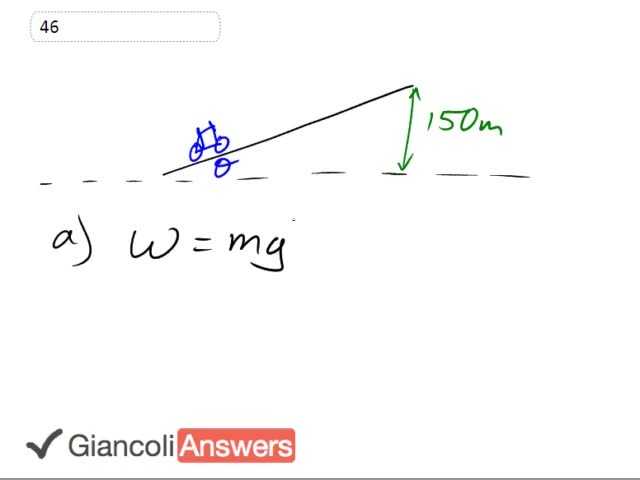
b)

In order to watch this solution you need to have a subscription.
The work done by, against gravity by the cyclist is going to be just 'mgh' in part A because there is no friction. And we'll substitute in 75 kilograms 9.8 Newton’s per kilogram, and the vertical change in height 150 meters and that's 1.10 times 10 to the 5 joules. That’s in the case with no friction. What's more interesting though is part B. Now we'll answer this by asking what is the work done by 1 full peddle stroke?
Let's draw a triangle illustrating what happens with 1 stroke. The cyclist will go up a distance called delta 'h' and then go along a distance delta'd'. And as delta'd' we know we're told that it's 5.1 meters. So the work of this peddle stroke will achieve though is this, is over this height delta 'h'.
So we'll say delta 'h' is delta 'd' times sine theta because 'h' is the opposite length of that triangle so we use sine and what we are talking about here is with one peddle stroke and what's the work done by that 1 peddle stroke. So the work done by 1 stroke of the peddles is 'mg' times delta 'h' which is 'mg' delta'd' sine theta. We can also say that the work done by 1 peddle stroke is the average force times the distance over which that force is acting and to be clear this 'd' here and this 'd' here have nothing to do with each other. The delta'd' is a distance 1 peddle stroke takes the cyclist which is 5.1 meters. And the'd' here is just the general formula for work force times distance, so in general the work done by one peddle stroke is the average force times the distance over which the stroke occurs and if we draw the circle that the peddles are traveling in sequence radius 'r' the force is always tangent to the circle that's what the question tells us. So that force is being exerted over this entire circumference. The circumference is 2 pie r. So the distance of 1 peddle stroke is 2 pie r. So that’s this distance here.
So we say that work of one peddle stroke is whatever that force is, which we're trying to find times 2 pie r. So we'll say this is the work of 1 peddle stroke, that also is the work of 1 peddle stroke so we can say that those 2 things are the same. 'mg' delta 'd' sine theta equals 'f' times 2 pie r.
So we'll solve for 'f' by dividing both sides by 2 pie r. And we get 'f' is 'mg delta'd' sin theta over 2 pie r and we'll substitute in numbers now. M is 75 kilograms 9.8 Newton’s per kilogram. 5.1 meters along the slope with each peddle stroke sine of 7.8 degrees divided by 2 pie and 'r' is the diameter given divided by 2. And that all equals 450 Newton’s.
For the fifth edition you have a couple of minor changes. One is the height of this hill is only 120 meters instead of 150. So for the fifth edition the part A answer is 8.82 times 10 to the 4 joules. And down here the slope angle has changed 7.5 degrees instead of 7.8. And so the fifth edition answer for the average force is 433 Newton’s.